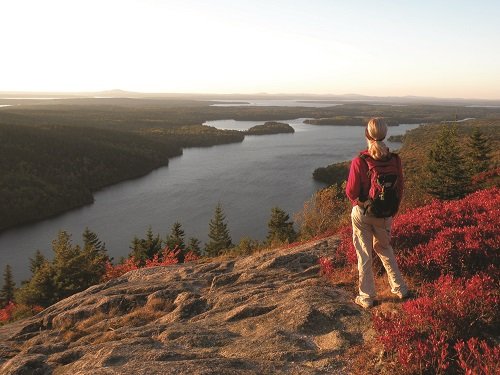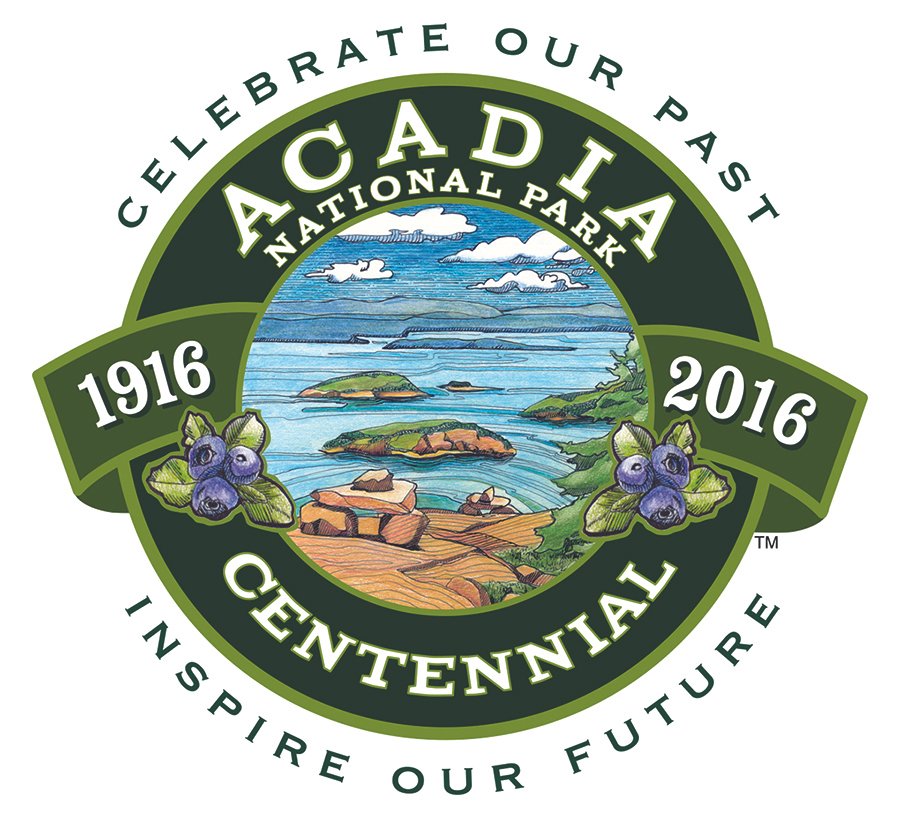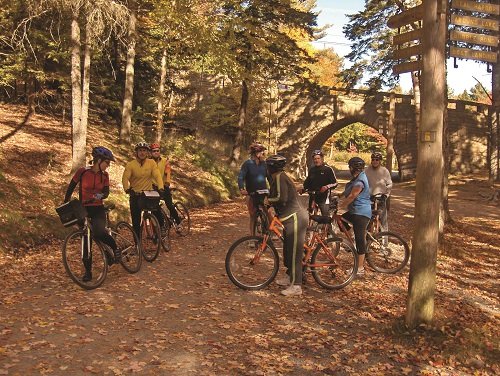Acadia’s centennial: 100s of ways to celebrate a national gem
Sunset over Long Pond from Beech Mountain. Photo: Carey Kish
By Carey Kish
Acadia National Park Centennial – Complete calendar of events & activities: www.acadiacentennial2016.org/events
ACADIA NATIONAL PARK marks the centennial of its founding this year with a big celebration highlighting a century of conservation and stewardship, and this summer and fall is prime time for actively exploring the beauty, history and culture of the park and its surroundings on foot, by bike, canoe, kayak or boat.
Friends of Acadia, the National Park Service and hundreds of supporting partners have organized an expansive calendar of events and activities. There is something for everyone to enjoy, from lectures, exhibits and workshops to nature walks and wildlife watching to music, dance, festivals and fairs and much more. Build a trip or two around events of interest, then pack your outdoor toys for a fun park visit.
“Acadia belongs to the people and the centennial is a community-driven celebration of the park, its founding and its future,” said Stephanie Clement, conservation director at the nonprofit Friends of Acadia, which helps support the park through conservation grants, volunteerism, education and outreach programs. “It’s a chance for everyone to celebrate their own unique relationship with the park.”
The view from the top of Cadillac Mountain. Photo: Heather Chandler
Permanent protection for the lands that comprise the bulk of Acadia National Park on Mount Desert Island was sought by citizens concerned about over-development in the early part of the 20th century. The tireless conservation advocacy of notables like George B. Dorr, Charles W. Eliot and John D. Rockefeller and many others eventually led to the establishment of Sieur de Monts National Monument by President Woodrow Wilson in 1916. In 1919, the monument became Lafayette National Park, and in 1929 the name was changed to Acadia National Park. The federal park was the first of its kind in the eastern U.S., and the first created entirely through private land donations.
Today, Acadia is one of the nation’s most popular national parks. In 2015, more than 2.8 million people visited the park to recreate, relax, refresh and reflect amid the pink granite mountains and blue ocean waters, spruce-studded islands and rocky headlands, leafy green forests and pristine ponds and lakes. From Blue Hill Bay to Frenchman Bay, Somes Sound to Cadillac Mountain, Isle au Haut to Schoodic Peninsula, the 49,000 acres of Acadia are an ecological bounty of bird, animal and marine life and a true national treasure.
“Acadia is a great resource for so many people for so many reasons, like the carriage roads and trails, the Park Loop Road and the road up Cadillac, the historic sites, scenic beauty and Native American history. These things and more make the park a very special, very accessible place,” Clement said, further noting that “you don’t have to go far or exert yourself physically to get a beautiful view.”
There are 45 miles of carriage roads in Acadia National Park, well marked with numbered way points like those shown on the Around-the-Mountain Carriage Road near Jordan Pond. Photo: Carey Kish
Hiking
A 120-mile network of well-maintained, marked, and signed trails throughout the park on MDI offer a plethora of possibilities to suit day hikers of every ability. The following rank as favorites among the many easy oceanfront strolls, moderate valley walks, strenuous mountain rambles and ladder climbs up steep cliff-sides.
The Ocean Path is an easy and accessible 2.2-mile hike along Frenchman Bay from Otter Point to Sand Beach that takes in many of the park’s most iconic sights, from the precipitous Otter Cliffs and cobbles of Monument Cove to the crashing surf at Thunder Hole and pink granite peaks of Gorham Mountain and the Beehive.
For six miles of nearly continuous panoramic views, traverse Cadillac Mountain, the highest mountain not only on the island but the entire Atlantic seaboard between Labrador and Brazil. Start near Blackwoods Campground and link the South Ridge and North Ridge trails over the 1,531-foot peak, an often busy but very worthwhile park highlight.
Tackle all or a portion of eight trails plus a section of carriage road over nearly 7 miles on the rugged Six Peaks Circuit. From Bald Peak and Parkman Mountain to Gilmore Peak and Sargent Mountain to Penobscot and Cedar Swamp mountains, this route will treat you to plenty of alpine-like terrain and far-reaching ocean views.
Test your mettle on the iron ladders of the Beech Cliff Trail, which in just a half mile leads to an airy ledge and stunning view over Echo Lake. Extend the fun another mile and a half with a jaunt to the firetower atop Beech Mountain and just beyond, a vista west to Mansell and Bernard mountains.
Eighteen miles of trails on Isle au Haut and another nine on Schoodic Peninsula round out Acadia’s wealth of hiking options.
A group of cyclists enjoying the expansive carriage trails. Photo courtesy of Summer Feet Cycling.
Mountain biking and road cycling
A 45-mile network of historic carriage roads wind through the eastern section of Acadia National Park, where a series of loop trips allow for leisurely rides ranging from a few hours to an entire day. Hybrid and mountain bikes are best suited for the wide, fine-gravel roads, financed and built under the supervision of John D. Rockefeller between 1913-40.
Eagle Lake is the second largest body of fresh water on the island and the six-mile circuit around its shore is perhaps the most popular ride in the park. The nearby Aunt Betty Pond Loop crosses numerous cascading streams in the aptly named Seven Bridges area, while the Day Mountain Loop serves up great views of the Cranberry Isles, Northeast Harbor and Southwest Harbor. In the deep forested crease between Cedar Swamp and Penobscot mountains, you’ll cross numerous old stone bridges on the Amphitheatre Loop.
Road cyclists will enjoy touring on the 27-mile Park Loop Road, which touches many of the most spectacular points in Acadia, from Sand Beach, Thunder Hole and Otter Cliffs to Jordan Pond, Bubble Rock and Eagle Lake. Negotiate the hairpin turns of the Cadillac Mountain Road for summit vistas worthy of the 7-mile round trip climbing effort.
Outside the park boundaries, more miles of island roads and byways beckon; many are lightly traveled, especially on the western side of the island. And at Acadia on Schoodic Peninsula, a new 9-mile network of bike paths is definitely worth the trip.
Visitors enjoying a paddle on the quiet side of Acadia. Photo courtesy of Summer Feet Cycling
Kayaking and canoeing
Myriad islands, inlets and coves along the scenic coastline and two dozen sparkling lakes and ponds inland across Mount Desert Island await paddling adventurers. Ocean winds and tides here can be tricky, so go with an experienced group or a guide.
Mount Desert Narrows at the north end of the island and the Porcupine Islands in Frenchman Bay just off Bar Harbor on the eastern side are popular sea kayaking trips. Hemmed in by the steep walls of Acadia, St. Sauveur and Norumbega mountains, a tour of Somes Sound is a chance to explore the only natural fjord in the eastern United States. Along the west shore of the island, Pretty Marsh Harbor and Seal Cove reward with a good look at beautiful Blue Hill Bay. Bear Island Light and Sutton Island are more demanding kayak destinations southwest of Seal Harbor.
Quiet water canoeists will like Little Long Pond for its great views of Penobscot Mountain, Jordan Pond for the classic profile of the Bubbles, and Eagle Lake for its sweeping look at Cadillac Mountain’s western flank. Paddle beneath the steep cliffs of Bernard and Mansell mountains at Long Pond, watch for hawks on the thermals over Beech Cliffs on Echo Lake, or take easy strokes at Seal Cove Pond, the westernmost pond on the island.
Harbor seals, porpoises and birds are a common sight from a boat cruise through the waters surrounding Acadia. Photo courtesy of Sea Princess Scenic Nature Cruises
Garden walks
Stroll the meandering paths of three painstakingly preserved and lovingly managed gardens, where the beauty and bounty of Mount Desert Island’s natural and horticultural landscapes are on full display.
In Northeast Harbor, over 50 varieties of rhododendron and azaleas are assembled in an inspirational Japanese-style garden at Asticou Azalea Garden, designed and built in 1956 by Charles K. Savage, a lifelong local resident and former owner of the historic Asticou Inn.
The 140-acre Thuya Garden, tucked into the west slope of Eliot Mountain overlooking Northeast Harbor, features a mix of semi-formal English border gardens and native Maine woodlands. Thuya Lodge is the former home of Joseph H. Curtis, Boston landscape architect, civil engineer, and late 18th century summer resident.
In the tranquil woods at Sieur de Monts Spring you’ll find the Wild Gardens of Acadia, where 400 species of trees, shrubs, flowers other native island plant life are represented on just one acre. Add the adjacent Sieur de Monts Nature Center and Abbe Museum to your visit in this peaceful park setting.
Passengers disembark the Cranberry Cove Ferry at Little Cranberry Island. Photo: Carey Kish
Boat tours and ferries around Mount Desert Island
Most visitors to Acadia enjoy its glorious geography from the land, but for a really different, eye-popping perspective, consider a guided boat cruise to see Mount Desert Island from the ocean waters surrounding it. Commercial tour operators in Bar Harbor and several other ports on the island offer a variety of boat tours.
Head out to sea on a whale watching trip, or visit a puffin colony on a remote, windswept island. Board a majestic fourmasted schooner and set sail on the winds and tides. Join the captain and crew of a real Maine lobster boat and work alongside them hauling lobster traps. Enjoy a one-of-a-kind adventure aboard the Starfish Enterprise with “Diver Ed” Monet, who brings the ocean to life with underwater video and audio equipment.
A handful of boat cruises offer special interpretive tours led by an Acadia National Park ranger, complete with the classic flat-brimmed hat and green and gray uniform, so be sure to inquire.
Public and private ferries serve Great and Little Cranberry, Swan’s, and Long islands, where the fishing villages and quiet lanes will have you reminiscing about simpler times past.
Rainy day activities
Maine’s coastal weather is fickle, so when the gray clouds gather and raindrops begin to fall, head indoors to the museums and historical societies showcasing the colorful human and natural history of Mount Desert Island.
Kids love lobsters and whatever other living creatures Diver Ed brings up from the sea bottom for the onboard touch tank. Photo courtesy of Dive-In Theater Boat Cruise with Diver Ed
The archaeological exhibits, workshops, demonstrations, and live performances at the Abbe Museum (downtown Bar Harbor and at Sieur de Monts Spring in the park) tell the fascinating story of the native Wabanaki, or “People of the Dawnland,” whose Micmac, Maliseet, Penobscot and Passamaquoddy tribes have lived in Maine for 10,000 years.
Historical societies in Bar Harbor, Tremont, Somesville, Great Cranberry Island and Islesford (the latter two accessible only by ferry) bring Mount Desert Island’s history to life through displays, artifacts, photos and documents.
The Mount Desert Oceanarium in Bar Harbor (not far from the Trenton bridge) has educational and entertaining exhibits on the life and processes of the ocean environment, including a touch tank where visitors can handle animals (with staff assistance).
In Tremont, the Seal Cove Auto Museum houses an impressive collection of more than 100 antique electric, steam and gasoline-powered automobiles and motorcycles dating to the late 1800s, many painstakingly restored while others remain in their original condition.
The Wendell Gilley Museum in Southwest Harbor is home to hundreds of decorative bird carvings by Wendell Gilley (1904-1983), a pioneer in the field and author of “The Art of Bird Carving: A Guide to a Fascinating Hobby,” one of the earliest instructional books on the subject.
Tips for visiting Acadia during this busy centennial year
All visitors must pay a fee to enter the park from May through October. Buy park passes for individuals and vehicles at park facilities and select other locations.
Consider non-consumptive modes of transportation to ease traffic congestion. Leave your car parked at the campground or lodging and ride the free Island Explore bus system, walk the village connector trails from Bar Harbor and Southwest Harbor or ride your bike to reach trailheads and other points in the park.
Many of the planned centennial events and activities are set outside the park, so be sure to visit and support the local host communities.
Consider visiting the most popular park destinations like Cadillac Mountain, Sand Beach and Thunder Hole during the quieter hours of the day, such as early morning or late afternoon. And be sure to try new areas and quieter locales, like Schoodic and Western Mountain.
Further resources
Acadia Centennial | www.acadiacentennial.org | 207-288-3340
Acadia National Park | www.nps.gov/acad | 207-288-3338
Friends of Acadia | www.friendsofacadia.org | 207-288-3340
Island Explorer | www.exploreacadia.com | 207-667-5796











